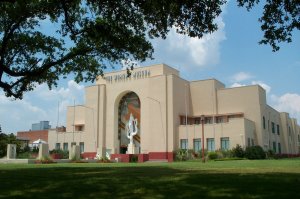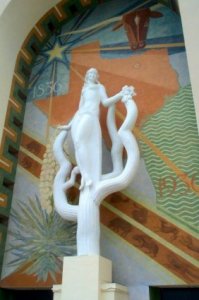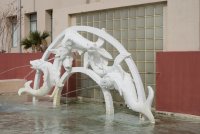|
|
Old Coliseum/Womens' Museum (2000-2011)
 To the north of the Founders' Statue stands a large building originally called the Fair Park "Coliseum." This imposing structure was designed by architect James Flanders. In 1910, it was constructed at a cost of $108,000 on land previously used as an outdoor livestock arena and baseball park.
To the north of the Founders' Statue stands a large building originally called the Fair Park "Coliseum." This imposing structure was designed by architect James Flanders. In 1910, it was constructed at a cost of $108,000 on land previously used as an outdoor livestock arena and baseball park.
$55,000 of the money used to construct the Coliseum was supplied by public subscription in 1909 (known as "Coliseum Year" at the State Fair). Originally, the building was to be used for horse shows and breeders' exhibits but it became instead an 8,000-seat auditorium. In this capacity it was host over the years to innumerable plays, pageants, speeches, band concerts, and vaudeville revues. In 1915 the Coliseum hosted the Jess Willard Championship Boxing Match.
 One of the most celebrated persons to appear on stage at the Coliseum during its brief period of glory was President Woodrow Wilson, who was Governor of New Jersey at the time of his visit to Fair Park. On "Woodrow Wilson Day" at the State Fair, Saturday, October 28, 1911, he addressed an audience of some 6,000 persons. Wilson's visit to Dallas was part of his campaign to secure the Democratic nomination for president in 1912. In this effort he was successful. Indeed, not only did he receive the nomination but also went on to win the presidency, defeating both former President Theodore Roosevelt (who ran on the Progressive Party or "Bull Moose" ticket), incumbent Republican President William Howard Taft, and Socialist Party leader Eugene V. Debs, who also spoke here, in 1914.
One of the most celebrated persons to appear on stage at the Coliseum during its brief period of glory was President Woodrow Wilson, who was Governor of New Jersey at the time of his visit to Fair Park. On "Woodrow Wilson Day" at the State Fair, Saturday, October 28, 1911, he addressed an audience of some 6,000 persons. Wilson's visit to Dallas was part of his campaign to secure the Democratic nomination for president in 1912. In this effort he was successful. Indeed, not only did he receive the nomination but also went on to win the presidency, defeating both former President Theodore Roosevelt (who ran on the Progressive Party or "Bull Moose" ticket), incumbent Republican President William Howard Taft, and Socialist Party leader Eugene V. Debs, who also spoke here, in 1914.
After the present Music Hall (originally known as the Fair Park Auditorium) was built in 1925, the Coliseum was no longer needed for its original purpose. During the years leading up to the 1936 Texas Centennial Exposition, the Coliseum was generally used to host agricultural exhibits during the State Fair.
 The building's brick exterior was covered with stucco during the 1935-1936 remodeling of the park, and radically restyled so as to match the "Texanic" Art Deco style of the new structures designed by George Dahl for the Centennial Exposition. It is this "new" exterior, now sixty years old, that visitors to Fair Park see today. Of particular note is the front of the building. Its most outstanding features are a large mural and a statue set into a niche. The statue, some twenty feet tall, is of a beautiful nude young woman standing upon a saguaro cactus (a species, incidentally, which is native to Arizona, not Texas). A Texas girl, Georgia Carroll, was the model. Known as "Gorgeous Georgia Carroll," she sang with Kay Kyser's Band during the 1930s and eventually became Mrs. Kyser. Georgia Carroll was also a fashion model and actress. The statue is called "The Spirit of the Centennial." It was designed by Raoul Josset and executed by Jose Martin.
The building's brick exterior was covered with stucco during the 1935-1936 remodeling of the park, and radically restyled so as to match the "Texanic" Art Deco style of the new structures designed by George Dahl for the Centennial Exposition. It is this "new" exterior, now sixty years old, that visitors to Fair Park see today. Of particular note is the front of the building. Its most outstanding features are a large mural and a statue set into a niche. The statue, some twenty feet tall, is of a beautiful nude young woman standing upon a saguaro cactus (a species, incidentally, which is native to Arizona, not Texas). A Texas girl, Georgia Carroll, was the model. Known as "Gorgeous Georgia Carroll," she sang with Kay Kyser's Band during the 1930s and eventually became Mrs. Kyser. Georgia Carroll was also a fashion model and actress. The statue is called "The Spirit of the Centennial." It was designed by Raoul Josset and executed by Jose Martin.
New York artist Carlo Ciampaglia designed the mural immediately behind the statue. It is the only one of the Italian artist's Fair Park murals that is uniquely Texan in theme. It features a large outline map of Texas, with the head of a longhorn steer in the upper right-hand corner, above North Texas. A flowering yucca plant can be seen in the lower left-hand corner, below South Texas. To the left of the steer's head is large-five pointed "Lone Star," from which beams of light are show radiating in all directions. One shaft of light illuminates most of North Texas, including the city of Dallas, represented by a large circle with a dot in the middle. Two angled friezes feature both the domestic and the wild animals of Texas. The year "1836" is painted just below the Lone Star, this being the year Texas won its independence from Mexico. The centennial year, "1936," is painted on the section of the mural consisting of alternating wavy, green lines. These represent the waters of the Gulf of Mexico.
 Below the statue and mural, extending out toward Holland Plaza, is a small reflecting pool and fountain. At the head of the pool is a half-circle of dancing flying fish. These were also designed by Raoul Josset and sculpted by Jose Martin. The creatures, with water spouting out of their mouths, seem to be leaping up out of the water on one side and diving back in on the other. After years of neglect, statue, mural, and fountain today look better than ever. Stashka Star completed conservation of the statue and mural in 1998. Conservator John Dennis restored the fountain in 2000. The total cost of the project, which was provided by private donors, was $140,000.
Below the statue and mural, extending out toward Holland Plaza, is a small reflecting pool and fountain. At the head of the pool is a half-circle of dancing flying fish. These were also designed by Raoul Josset and sculpted by Jose Martin. The creatures, with water spouting out of their mouths, seem to be leaping up out of the water on one side and diving back in on the other. After years of neglect, statue, mural, and fountain today look better than ever. Stashka Star completed conservation of the statue and mural in 1998. Conservator John Dennis restored the fountain in 2000. The total cost of the project, which was provided by private donors, was $140,000.
In October 2000, the old Coliseum became the Women's Museum after F. & S. Partners renovated both the exterior and the cavernous interior at a cost of about $25 million. Wendy Evans Joseph of New York was the project's design architect. However, although it attracted some 1.5 million visitors in more than a decade of operation, from 2006 onward the museum operated at a ever-increasing loss, until it closed in the late fall of 2011. Currently, the building is unoccupied.
Copyright © 1996-2012 by Steven Butler, Ph.D. All rights reserved.